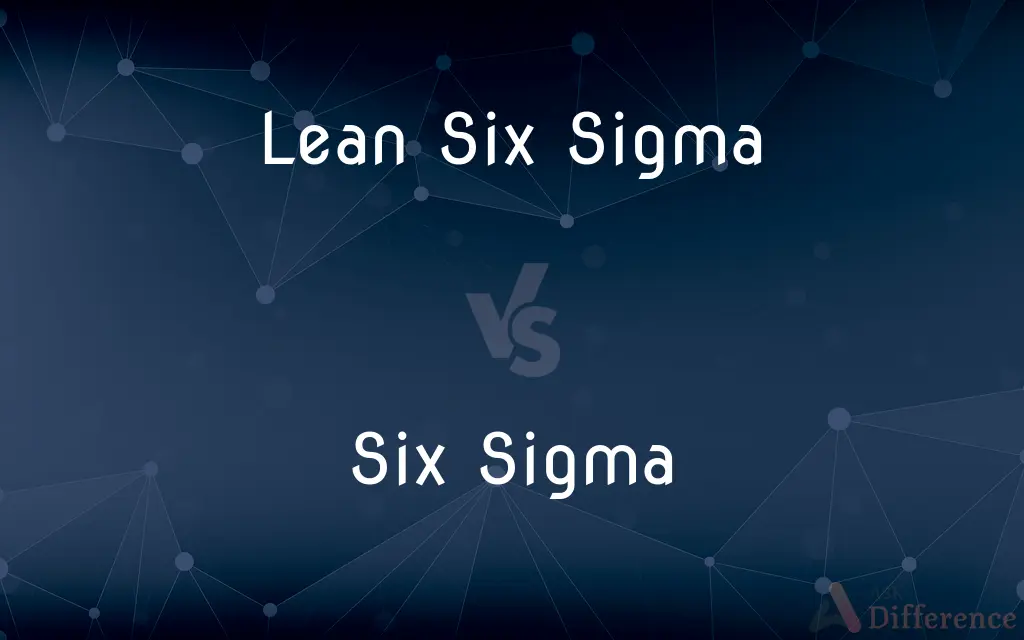Lean Six Sigma vs. Six Sigma — What's the Difference?
By Tayyaba Rehman — Published on December 22, 2023
Lean Six Sigma combines Lean's efficiency principles with Six Sigma's quality improvement methods, whereas Six Sigma solely focuses on eliminating defects and improving quality.

Difference Between Lean Six Sigma and Six Sigma
Table of Contents
ADVERTISEMENT
Key Differences
Lean Six Sigma merges the best of two methodologies: the speed and waste reduction of Lean with the defect elimination and process improvement focus of Six Sigma. Conversely, Six Sigma, standing on its own, emphasizes a data-driven approach to eliminate defects and enhance process quality.
Lean Six Sigma, by its combined nature, aims to streamline processes and reduce waste while ensuring high quality. On the other hand, Six Sigma prioritizes achieving consistent and defect-free outcomes through meticulous statistical analysis and control.
Lean Six Sigma uses tools from both Lean and Six Sigma to deliver faster, more efficient processes with fewer defects. In contrast, Six Sigma's tools, like DMAIC (Define, Measure, Analyze, Improve, Control), are specifically geared towards analyzing and refining processes for quality improvements.
The driving force behind Lean Six Sigma is the dual goal of waste elimination and quality enhancement, ensuring processes are both lean and effective. However, Six Sigma's core mission revolves around reducing variability and ensuring processes are statistically sound and consistent.
To encapsulate, while both Lean Six Sigma and Six Sigma target process improvement, the former integrates efficiency and quality tools for comprehensive enhancement, whereas the latter zeros in on quality assurance and defect reduction.
ADVERTISEMENT
Comparison Chart
Primary Purpose
Enhance efficiency and quality
Improve quality by eliminating defects
Focus
Waste reduction and defect elimination
Defect elimination and process consistency
Toolset
Combines tools from both Lean and Six Sigma
Primarily statistical tools like DMAIC
Core Principles
Speed, waste reduction, and quality improvement
Data-driven quality improvement
Approach
Integrative (Lean for speed, Six Sigma for quality)
Singular (Focused on quality)
Compare with Definitions
Lean Six Sigma
Lean Six Sigma uses tools from both methodologies for optimal results.
The implementation of Lean Six Sigma led to faster production cycles with fewer errors.
Six Sigma
Six Sigma employs statistical tools for process improvement.
The Six Sigma team utilized DMAIC to refine the production line.
Lean Six Sigma
Lean Six Sigma is a hybrid approach targeting efficiency and quality.
With Lean Six Sigma, wasteful practices were reduced, and product defects plummeted.
Six Sigma
Six Sigma emphasizes data-driven decision-making.
With Six Sigma, the company made choices based on hard data, not gut feelings.
Lean Six Sigma
Lean Six Sigma integrates Lean's speed with Six Sigma's quality.
The company adopted Lean Six Sigma to streamline operations and enhance product quality.
Six Sigma
Six Sigma is a methodology to eliminate defects and improve quality.
After adopting Six Sigma, the company reported a significant drop in product returns.
Lean Six Sigma
Lean Six Sigma seeks to maximize value by eliminating waste and defects.
Lean Six Sigma principles transformed the supply chain, making it more responsive and precise.
Six Sigma
Six Sigma prioritizes reducing variability in processes.
Through Six Sigma, the firm achieved more predictable and consistent outputs.
Lean Six Sigma
Lean Six Sigma balances the goals of speed and quality in processes.
The Lean Six Sigma training emphasized both rapid delivery and consistent quality.
Six Sigma
Six Sigma aims for near-perfect consistency in outcomes.
Six Sigma standards mean fewer than 3.4 defects per million opportunities.
Common Curiosities
Which methodology is better for rapid process improvement?
Lean Six Sigma, due to its inclusion of Lean principles, often leads to quicker process improvements.
Are the tools used in Lean Six Sigma different from Six Sigma?
Lean Six Sigma uses a combination of tools from both Lean and Six Sigma, while Six Sigma uses primarily its own set of tools.
What is the primary objective of Lean Six Sigma?
Lean Six Sigma aims to improve efficiency and quality by merging Lean and Six Sigma principles.
Does Lean Six Sigma also use DMAIC?
Yes, DMAIC is used in both Six Sigma and Lean Six Sigma for process improvement.
What does DMAIC stand for in Six Sigma?
DMAIC stands for Define, Measure, Analyze, Improve, and Control, a key methodology in Six Sigma.
Which methodology is more comprehensive?
Lean Six Sigma is often seen as more comprehensive since it addresses both efficiency and quality.
How is Six Sigma distinct from Lean Six Sigma?
Six Sigma focuses exclusively on quality improvement and defect reduction, while Lean Six Sigma also emphasizes efficiency.
Can a company implement both methodologies separately?
Yes, though Lean Six Sigma integrates them, companies can apply Lean and Six Sigma independently.
Can Lean Six Sigma be applied to any industry?
Yes, Lean Six Sigma principles are versatile and can be applied across various industries.
Is training required to implement Lean Six Sigma or Six Sigma?
Yes, proper training is crucial for both methodologies to ensure effective implementation.
Are there certification levels in both methodologies?
Yes, both offer certification levels, like Green Belt, Black Belt, and Master Black Belt.
Which methodology is older?
Six Sigma originated in the 1980s at Motorola, while Lean Six Sigma evolved later as an integration of Six Sigma and Lean.
Which methodology requires more extensive training?
Both require substantial training, but Lean Six Sigma might necessitate a broader understanding due to its dual focus.
Are there any drawbacks to implementing Lean Six Sigma over Six Sigma?
The choice depends on organizational needs. Lean Six Sigma requires understanding two methodologies, which might be more complex, but it offers a broader toolset.
How long does it typically take to see results with Six Sigma?
It varies, but Six Sigma projects can take a few months to over a year, depending on complexity.
Share Your Discovery

Previous Comparison
Fleas vs. Gnats
Next Comparison
DNA Nucleotides vs. RNA NucleotidesAuthor Spotlight
Written by
Tayyaba RehmanTayyaba Rehman is a distinguished writer, currently serving as a primary contributor to askdifference.com. As a researcher in semantics and etymology, Tayyaba's passion for the complexity of languages and their distinctions has found a perfect home on the platform. Tayyaba delves into the intricacies of language, distinguishing between commonly confused words and phrases, thereby providing clarity for readers worldwide.












































